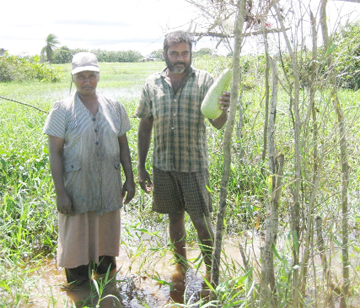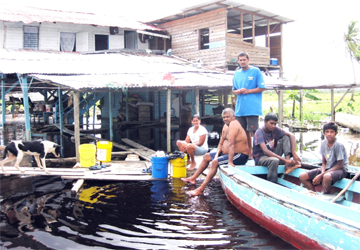-flooded Mahaicony residents ask
Even as hopes rise with the drop of the water level in the Mahaicony Creek, residents say there is nothing else for them to do to earn a living as they have lost their crops.
They told this newspaper yesterday that their lives have been interrupted due to the flooding which swamped their livelihoods from around Christmastime and it would remain so for the next three months.
in front of their flooded yard.”] in front of their flooded yard.”]![20090116manandwoman Gainda Persaud and his wife, Lakranie Durga [doing laundry] in front of their flooded yard.](https://s1.stabroeknews.com/images/2009/01/20090116manandwoman.jpg)
They were pleased that the water has been receding slowly since Tuesday and that the Maduni sluice has been closed but they were still fearful that the level would rise again once the heavy rainfall continues.
Describing their situation as “real punishment,” the residents said they had been running out of foodstuff until help came from the government and the Indian Arrival Committee last Saturday. But that too they said is almost finished.
Seeranie Latchman of Pine Ground has had to “boil dhall and cook aloo [potato] and depend on one and two fish that we ketch in the yard. We glad fuh the foodstuff they give we; whatever little we get we thankful for.”
She said their kitchen garden has been destroyed and they now have to pay $100 for five boras, $150 for a boulanger and $300 for a pound of ochro. She also said that the shops in the area are selling potatoes for $100 per pound and dhall for $100 per pint.
She said although her yard is flooded she still has to cook on her fireside because “kero expensive – $1100 for a gallon and me can’t afford that.” She, like many other housewives, has to make a bridge to the fireside just to make life a little easy.

Her husband, Kesarchandra Kawal, a small-scale livestock and rice farmer said he did not plant this crop because of the flood. He said he bought seed-paddy for $4500 per bag and now he wants to resell it for even $2000 but nobody wants to buy it. Two bags of the paddy had even gotten wet and spoilt.
He has 60 head of cattle together with his sons, Jaichandra and Kadirchandra and the animals are in the backdam. He said he could not go to see them in the water “because me gon get sick.”
His sons related to him though that about 11 calves have died and the cows’ feet have become swollen from being in the water for so long.
He said he is taking care of his goats around the yard and had to make “flooring” for them to sleep on. The goats, he said have to “swim in the water to find grass and graze.” The animals are also feeding on his dying bora, boulanger and other vegetables that he had on a high spot.

The man’s brother, Sewsankar Kawal said that even after the area becomes dry again rice farmers would not be able to cultivate their crops.
Further, he said he wants to relocate from the creek and has applied for a house lot since 1998 and still cannot get through. He said that one month ago he checked with the Ministry of Housing and was told that “the only house lot me gat fuh get is at the cemetery and me walk out.”
He also said that “only when flood come then dem does come in hey and say dem gon give house lot. Me can’t stay in this place anymore. All the toilets overflowing and me gat me wife and 16-year-old daughter; whey dem must go?”
Over at Gordon Table, Easundeo and Nirmala Ally were in their yard – where the water had receded completely from one section – looking at what remained of their kitchen garden. Esaundeo, a labourer said that he is currently not earning an income and is faced with the reality that that would be so until the water completely recedes in about three months.
Another resident, Gainda Persaud declared, “This place gat too much punishment; wah the government ah do wid we in hey? We nah have no greens or nothing to cook. No work can’t go on; everything stall up.”
He lost his vegetables from his kitchen garden including 70 roots plantain suckers, ochro and bora and said “me punish to plant them and me din even enjoy dem.”

One of his calves, he said died from cramp and his aquarium fish and hassar that he had in a pond to sell “get away “so me nah have any business at all.”
He said too that “government should give we more compensation because when we plant the seed that they gon give we the flood gon come again.”
He too related that the water level has dropped and said “at least we can see the dam.”
When this newspaper approached Kenno Dayal, a labourer and asked how he was doing, he responded, “this is terrible water so me can’t do good in this situation.” He said he is not getting any jobs right now because the rice farmers he worked with have lost their crops.
He said his kitchen garden has been destroyed and the little savings he had is almost finished. Although he is disgusted with the flood, Dayal still acknowledged that “Mahaicony is a beautiful place but only in the dry weather.”

He said he rears poultry and that about eight of his ducks “swim away” in the floodwaters and got lost.
The residents were happy that the canal at Hope, East Coast would be dug to ease the flooding because “if they have to blow [release] the water steady pon we, what gon happen?”
Shankumar Persaud told Stabroek News that he had always talked about making the canal at Hope and is relieved that it would finally be realized. However he feels that that canal alone would not be able to “take off” all the water.

He said once there are heavy downpours the water may still have to be released through the Maduni sluice and said another outlet is needed between Mahaica and Mahaicony. “That would help to save Mahaicony for sure,” he opined.
